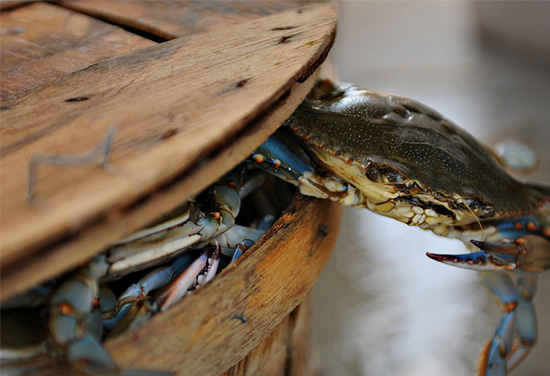Chesapeake Bay’s blue crab abundance drops
A boost in the number of spawning-age females tempers the news of this Bay-wide decline.
The blue crab population in the Chesapeake Bay has dropped, but a substantial boost in the number of spawning-age females has offered officials a piece of good news in spite of this disappointing decline.
According to the results of the annual winter dredge survey, which measures the blue crab population in Maryland and Virginia, the number of spawning-age females in the Bay has risen 52 percent. The Chesapeake Bay Program tracks this number as an indicator of Bay health, and an increase is a sign that management methods to conserve adult female crabs are working. But an overall decline in the Bay’s blue crabs—from 765 million in 2012 to 300 million in 2013—could lead to the tightening of commercial harvest restrictions.

Image courtesy Benjamin Wilson/Flickr
Scientists have attributed the decline in blue crabs not to overfishing, but to high mortality rates among juveniles. While last year’s winter dredge survey measured an unprecedented number of juvenile crabs in the Bay, last summer and fall saw an alarming loss of blue crab habitat and a large influx of red drum, which often feed on young crabs. Young blue crabs are also known to feed on each other when population densities are high.
“It is important to keep these results in perspective,” said Jack Travelstead, commissioner of the Virginia Marine Resources Commission (VMRC), in a news release. “Five years ago this fishery was declared a federal disaster. That is no longer the case: overfishing is no longer occurring, a good fisheries management framework is in place, the stock is healthy and spawning-age females are doing well. If not for the disappointingly small reproductive year class we would have much to celebrate.”
In an effort to make up for this shift in blue crab abundance, Maryland, Virginia and the Potomac River Fisheries Commission (PRFC) are pursuing strategies to establish a 10 percent cut in the commercial harvest of female blue crabs. Both Maryland and the PRFC will consider adjusting or enacting daily bushel limits, which have been put in place in Virginia. Maryland and Virginia will also consider shortening their crab seasons, and it seems likely that Virginia’s winter dredge fishery will remain closed.
The Chesapeake Bay Stock Assessment Committee (CBSAC) will draft their 2013 Blue Crab Advisory Report over the next few weeks.
Read more about the 2013 winter dredge survey results.

Comments
There are no comments.
Thank you!
Your comment has been received. Before it can be published, the comment will be reviewed by our team to ensure it adheres with our rules of engagement.
Back to recent stories